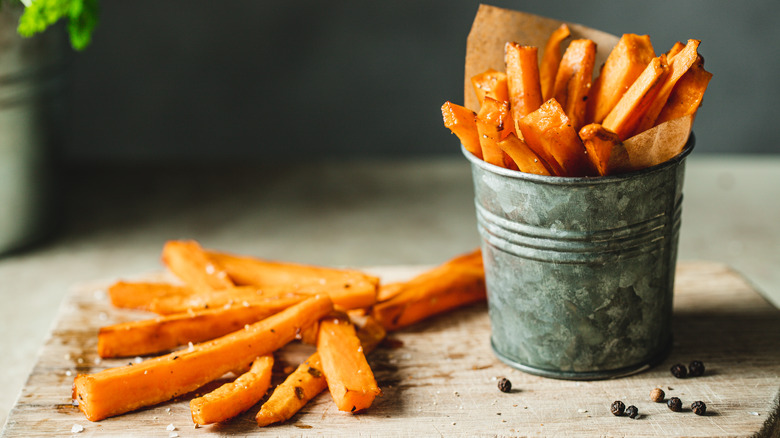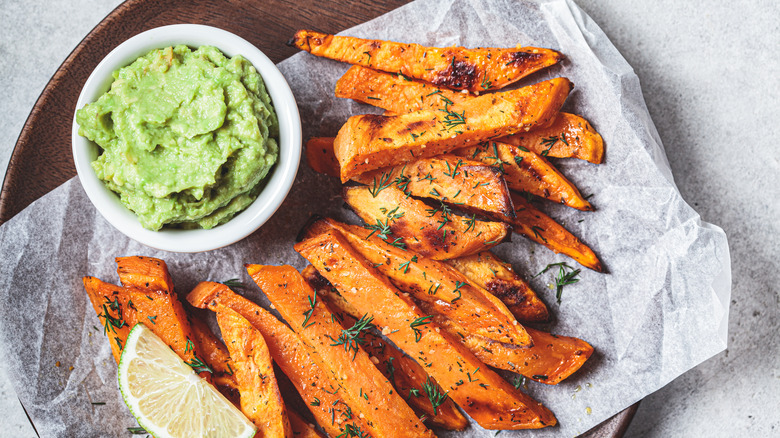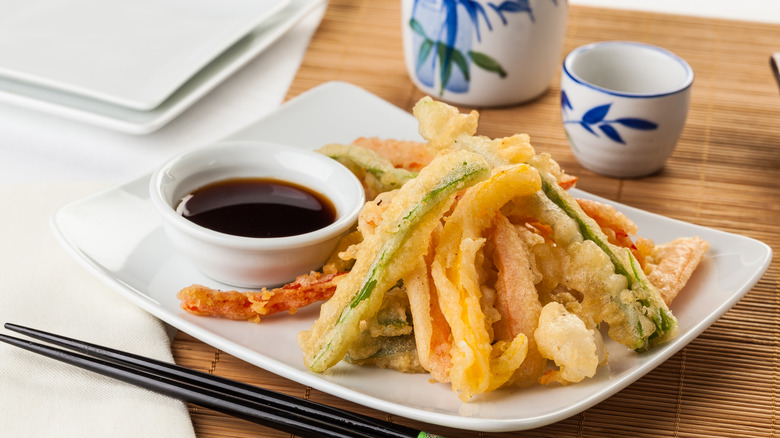The Secret Ingredient You Need To Make Sweet Potato Fries Way Crispier
Seltzer is an indispensable ingredient in countless drink recipes, but have you considered using it in cooking? You'll want to try adding bubbly soda water to your recipe for sweet potato fries for a perfectly crisp and utterly craveable texture. Sweet potato fries are mainstays on restaurant menus, where they accompany burgers, steaks, or shine as an appetizer all on their own. However, without the power of a restaurant deep-fryer, your from-scratch fries may turn out as a pile of soggy orange sticks.
A coating of seltzer, in combination with cornstarch, can easily help you avoid this pitfall. Cornstarch is lighter than all-purpose flour, so the coating won't turn out dense, and the carbonation in seltzer helps to form air pockets in the batter for an extra light, crispy, blistered coating. When you coat your sweet spuds in this mixture and submerge them in hot oil, the carbonation bubbles up vigorously, make for an impossibly airy coating that won't become weighed down after removing the fries from the oil. Carbonation also carries some acidity, which discourages too much tough and chewy gluten from forming in your batter. The result? Crispier fries that also maintain their crunch.
Pairing and flavoring your fries
What makes this style of batter really sing? The science is in the combination of cornstarch and seltzer, and what each ingredient contributes to the mix. Seltzer behaves in a similar way to baking powder or soda, which provide carbon dioxide. This creates air bubbles that get trapped in the batter and make for a light and airy crust. It's important to use a fresh, previously unopened bottle of seltzer straight from the fridge, when it's still as fizzy as possible. Old soda water can go flat and lose those critical "bubbly" properties. Cold seltzer also loses carbonation at warmer temperatures, which is why it should be cold when you add it to your batter.
Meanwhile, cornstarch ups the starch content of the batter to absorb excess moisture and prevent too much gluten formation. The goal of crisply frying foods is to eliminate water, as moisture inhibits crispness. Gluten, meanwhile, usually makes flour-based products tougher and chewier, which isn't ideal when you want a light, crunchy, shattering shell around your sweet potato fries. As previously mentioned, cornstarch is lighter than other flours, and it's also gluten-free. Like any starch, cornstarch also absorbs moisture, making your batter crispier. More starch in your fry batter is favorable, and cornstarch is also an odorless and flavorless option that won't distract from your fries.
Other ways to enjoy your batter
Once you've successfully used the cornstarch-seltzer batter combo, you'll want to try out a dozen other uses for the stuff. Vegetables of all kinds love this tempura-style treatment, and it's fun to fry a wide selection of veggies (think carrots, cauliflower, broccoli, and zucchini) and serve then as an appetizer with soy dipping sauce. You can also try your hand at sauces like sriracha aioli, which brings both creaminess and heat, while a zesty avocado dipping sauce incorporates bright citrus and herbs. Notably, these sauces also pair well with sweet potato fries.
You can also swap beer for seltzer and fry up some beer-battered fish, which happens to go perfectly with sweet potato fries as a variation on fish and chips. You can also serve the fish in tacos with your favorite salsa. You can even take your chicken tenders to another level with this style of coating, or make shrimp tempura and roll it into homemade maki sushi with cucumber, nori, and sushi rice.
You can also get wild with fried sweets for dessert, like battered Oreos, Twinkies, and even chocolate bars for an at-home take on carnival favorites. Serve tempura-fried bananas with peanut butter and chocolate sauce, and if you really want to blow minds, you can try turning tempura batter into an ice cream topping.


